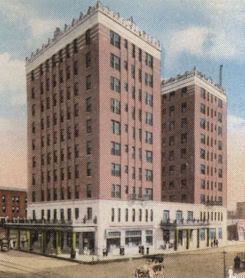

Instead, this post explores OTHER downtown Oklahoma City hotels (or similar temporary sleeping quarters like the USO Club and the "Y's"), past, present, and future. I expect this post to be expanded as changes occur or other items come to my attention.
Generally, the buildings are listed by date of construction, with some variance. Click on a hotel name to move to the next hotel. Unless stated otherwise, images can be clicked for larger pics. Read on to view downtown's Hotel History ...
THE PAST. Please let me know if there are other hotels than those shown below which should be added (I've left a few out deliberately as being "unworthy"). Most of the buildings shown below are gone, a few converted to other purposes, but all are remembered here as "downtown hotels" gone by.
The Lee, Lee-Huckins, Huckins. What would become the Lee-Huckins, and later the Huckins, started out as the 150 room Lee Hotel built in 1900 by Oscar G. Lee at the southeast corner of Main and Broadway. About the Lee, Terry L. Griffith, Oklahoma City – Land Run To Statehood (Arcadia Publishing 1999), says that the Lee contained the city's first electric elevator and that famous guests were "Buffalo" Bill Cody, then New York Gov. Teddy Roosevelt (during the 1900 Rough Riders Convention). Edwards & Ottaways' Vanished Splendor, Vol. I (Abalache Book Shop Publishing Co. 1982) says that (speaking of the Lee-Huckins), "Certain floors were reserved for men only, one for single women, and several for married couples." The hotel and its annex were demolished in 1971. Lee sold the property to Joseph Huckins in 1906 and the property became the "Lee-Huckins."
Credit: Edwards & Ottaways' Vanished Splendor, Vol. I (Abalache Book Shop Publishing Co. 1982)
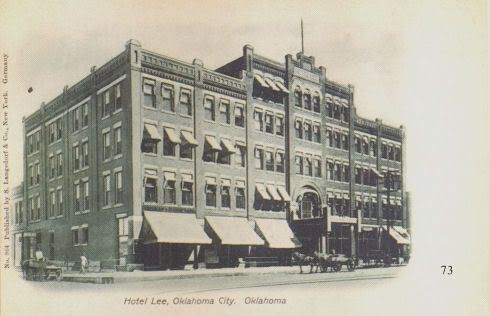
The 1908 Fire To the Lee-Huckins
Credit: Oklahoma City Metropolitan Library System
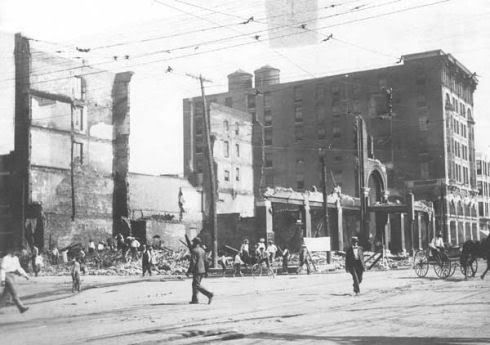
Reborn In 1910 From The Ashes, From Doug Dawgz Collection (next 4 pics)
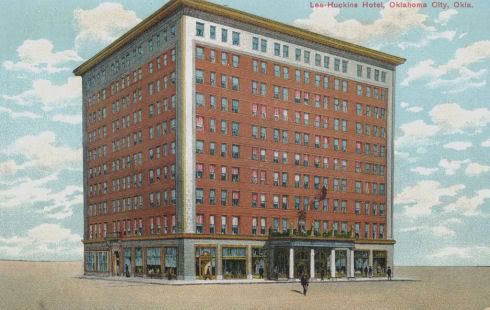
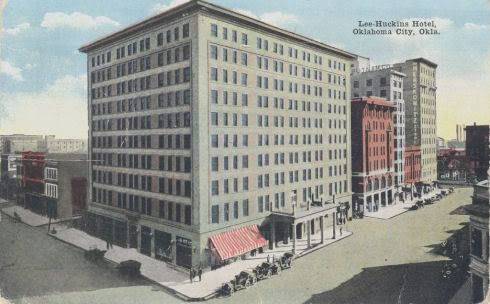


Everyone Had A Pot To Spit In
Credit: Oklahoma City Metropolitan Library System
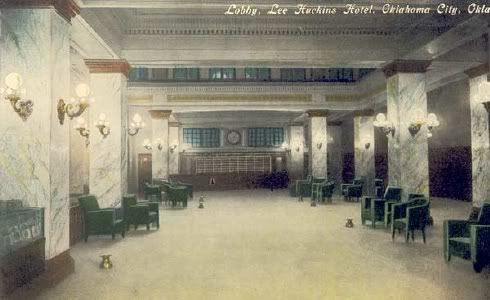
Gov. Charles N. Haskell (seated, right-of-center, bow tie) Meets With Staff In Temporary Quarters
Credit: Oklahoma City Metropolitan Library System
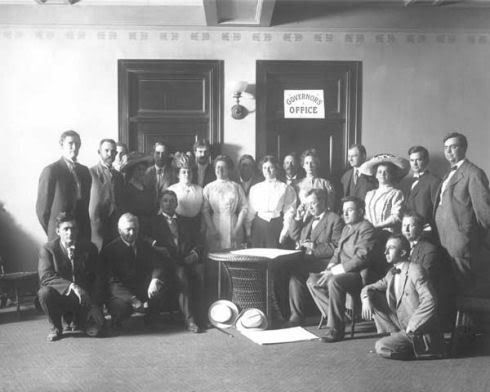
After a 1930s Revision Showing Parking Behind the Outside Wall
Credit: Edwards & Ottaways' Vanished Splendor, Vol. II (Abalache Book Shop Publishing Co. 1983)
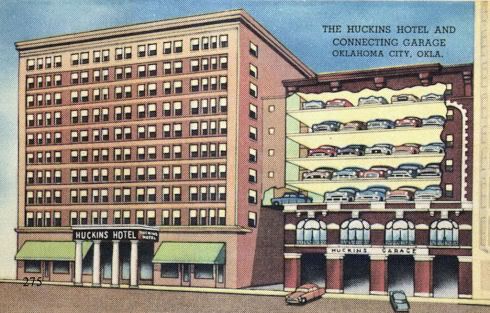
The Alamo. The 2-story Alamo was built in 1901 at 217 W Second (now Kerr). A brief article by Larry Johnson at the Oklahoma City Metropolitan Library System says, "The Alamo, a short walk from the Frisco station, served the city from 1901 to 1935 when it was torn down to become a parking lot and eventually Bank of Oklahoma Plaza."
Credit: Oklahoma City Metropolitan Library System
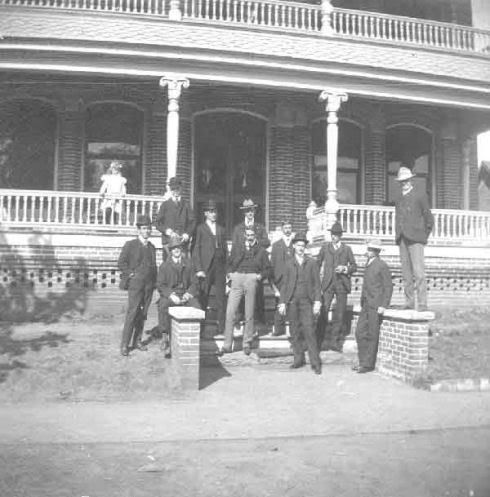
The Illinois. Not far behind, time-wise, was the Illinois. This 4 story structure was built around 1903 at 217 W Main. Larry Johnson's article at the Okc Metropolitan Library System says, "This ornate four-story hotel was not very large, but it did feature a café and a barber shop on the first floor." Before it moved across the street, Kress came to occupy the 1st floor, as shown in the 2nd picture below. After it was destroyed (I don't know when), its "space" became part of the John A. Brown Department Store.
Credit: Oklahoma City Metropolitan Library System
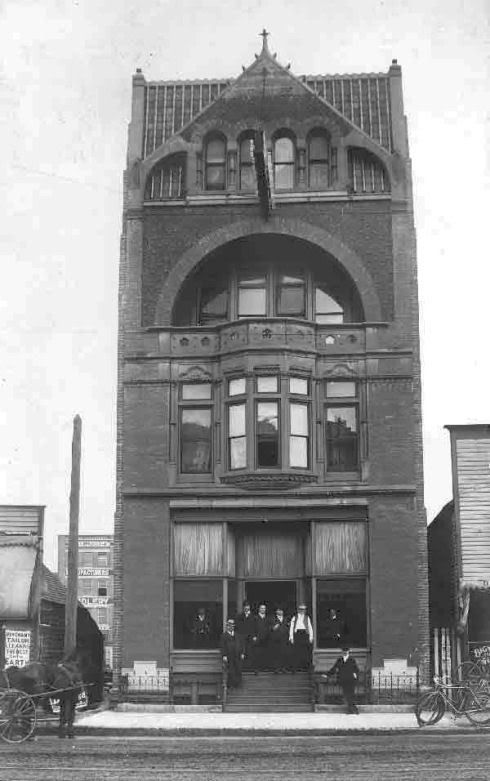
Credit: Terry L. Griffith, Oklahoma City – Statehood To 1930 (Arcadia Publishing 2000)
(larger image not available)
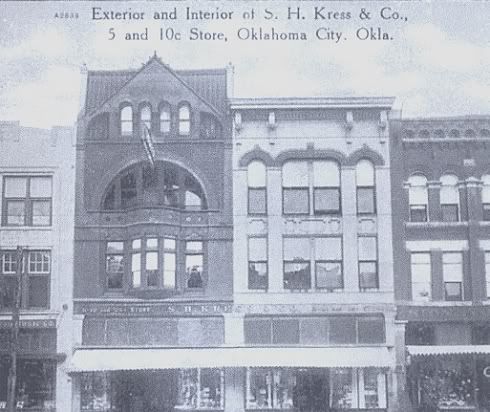
The Threadgill/Bristol Hotel. It was at the NE corner of Broadway and 2nd (now R.S. Kerr – the west part of the Broadway/Kerr parking garage now occupies the space). A postcard in Terry L. Griffith's Oklahoma City – Land Run To Statehood (Arcadia Publishing 1999) (not shown here) is identified as "circa 1903", so it was apparently built at least by then. The postcard from my collection, below, has a postmark of 1908. It was renamed the Bristol shortly after 1910 and, as such, it remained "in place" until some time during the 1960s (I think).
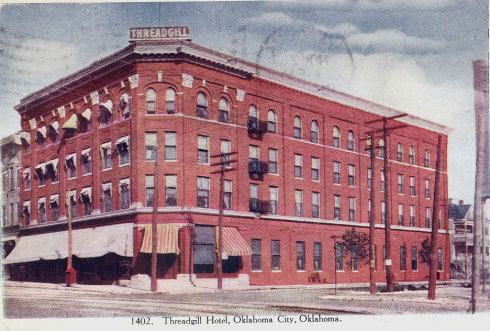
The Bristol
Credit: Oklahoma City Metropolitan Library System
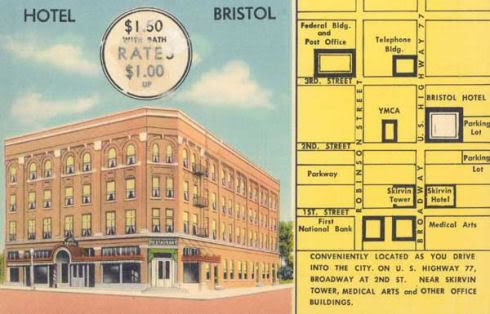
Another, From the 1930s But Brush-Stroked
To Modernize The Cars From A 1910s Postcard
From Doug Dawgz Collection (larger image not available)
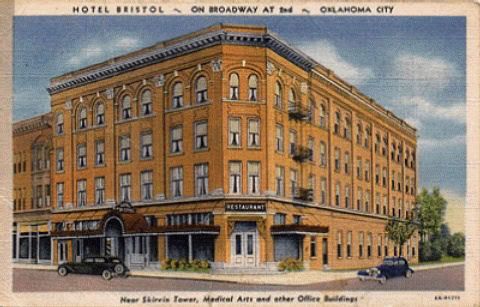
1930s Stationary With the Kingkade
Apparently By Then Under Common Ownership
From Doug Dawgz Collection (larger image not available)
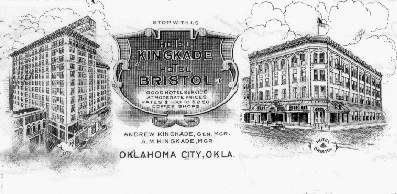
1956-1957 Views In Its Latter Days
Credit: Oklahoma City Metropolitan Library System (next 3 pics)
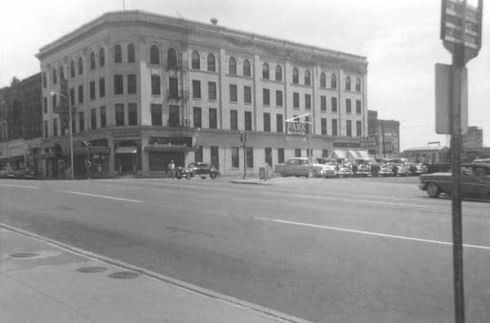
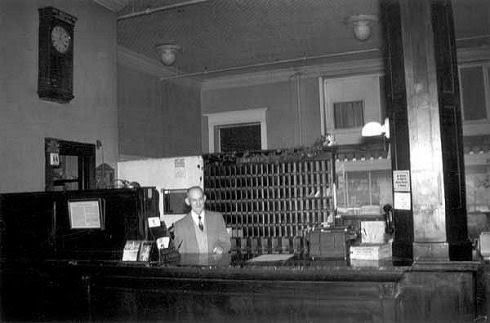
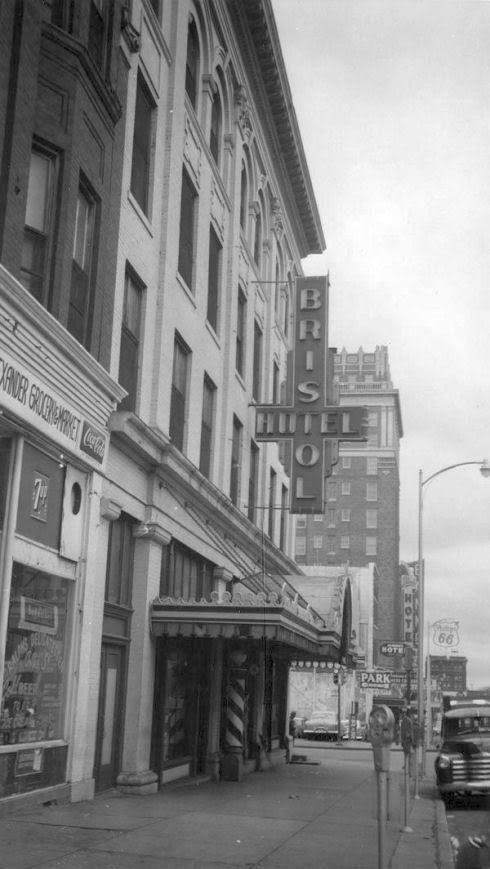
The Marion and Cline. I'm grouping these vintage hotels together since they were both built at about the same time, neither would be considered as being "the place to stay," both were built on NW 10th, but, more importantly, both are a part of Greg Banta's Midtown Renaissance project today. A June 16, 2006, Oklahoman article by Steve Lackmeyer roughly dates the buildings – 1908 for the Marion and 1910 for the Cline. An excerpt from the article reads,
Two MidTown hotels, both almost a century old, were recently added to Greg Banta’s growing MidTown Renaissance development.Except for The Downtown Guy's pic, I don't have any images of the buildings prior to those I took last year, below, so you'll have to use your imagination as to how they may have originally looked ...
Banta completed a $265,000 purchase of the 98-year-old Hotel Marion, 110 NW 10, on Thursday. He bought the 96-year-old Cline Hotel, 1018 N Harvey, on May 31 for $389,380.
Both hotels are considered longtime eyesores along NW 10, which is being targeted for redevelopment by the city as a connection between St. Anthony Hospital and the Oklahoma Health Center.
"It’s really good timing for the community," said Dave Lopez, president of Downtown Oklahoma City Inc. "So many of Greg’s investments are helping the area move forward."
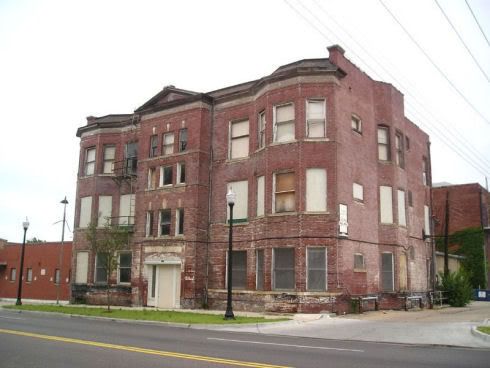
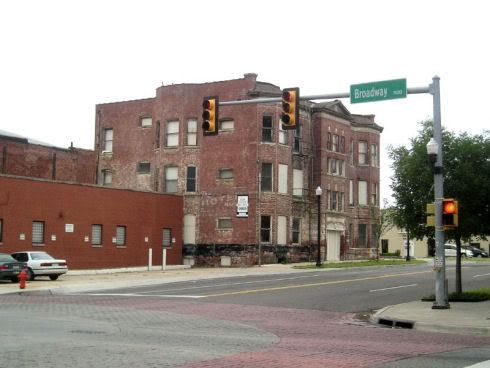
The Cline In 2006

The Cline Several Decades Earlier
Credit: The Downtown Guy
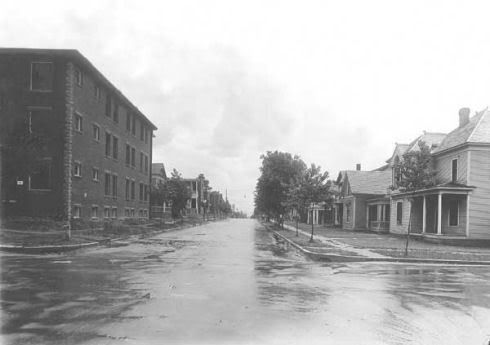
St. Nicholas Hotel. At 900 N. Broadway, the St. Nicholas commenced operation in 1910. It became the Earl Hotel in 1952 but went back to it's original name when it was acquired by J.D. Lobb in the mid-1980s. A later foreclosure caused the building to change hands again and I haven't researched the current owner. It is no longer used as a hotel. The postcard below, from Edwards, Oliphant & Ottaways' Vanished Splendor, Vol.III (Abalache Book Shop Publishing Co. 1985), shows what I guess to be a 1930s automobile.
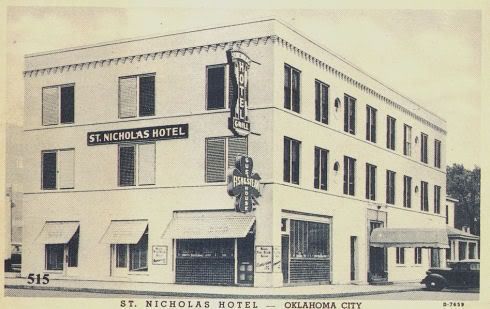
Broadway/Lamar/Noble Hotel. Edwards, Oliphant & Ottaways' Vanished Splendor, Vol.III (Abalache Book Shop Publishing Co. 1985) locates this building at 421 N. Broadway. Originally built in 1910 as the Broadway or Broadway Central Hotel, it became the Lamar in 1942, and, in 1964, the Noble Hotel. It closed in 1973 and became a parking lot shortly thereafter. Were it to exist today, it would be across the street (west) and a little north of the former Oklahoman building.

Spriggs Hotel. Edwards & Ottaways' Vanished Splendor, Vol. II (Abalache Book Shop Publishing Co. 1983) identifies this 1910 building at 801-803 N.W. 9th and provides the image below. Originally built by Dr. Alfred R. Spriggs, in 1961 the columns were removed and it became the St. Ann Apartments. When the book was written, the building still existed as the St. Ann, but it's gone today. Ironically or not, the County Assessor shows the property to be owned by St. Anthony's Hospital.

Martinique Hotel. Edwards & Ottaways' Vanished Splendor, Vol. II (Abalache Book Shop Publishing Co. 1983) provides the 1st image and says that the building opened in 1911 at 112 N.W. 7th. It became the Maxwell House Apartments in 1960, as shown in the pic I took on 3/28/2007, below.

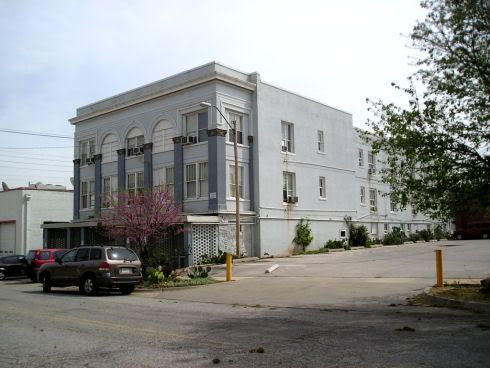
The Kingkade & Lawrence. Both were originally built in 1912, the Kingkade by Andrew Kingkade at 19 West Grand and the Lawrence by E.L. Lawrence immediately next door (east) at 17 West Grand. Both were originally the same height (8 stories) but, as shown in the postcard below, the Kingkade added 3 additional floors. Edwards & Ottaways' Vanished Splendor, Vol. I (Abalache Book Shop Publishing Co. 1982) says, "After World War II the Kingkade gradually declined along with downtown hotels all over the country, until the coming of the Myriad Convention Center brought its history to an end. After the 1968 Thanksgiving dinner served in its coffee shop, the Kingkade ceased operations and was soon razed."
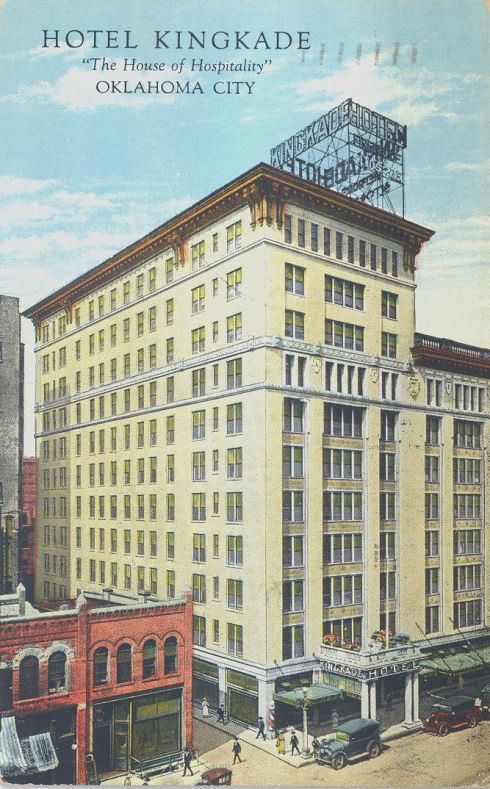
The Swan/Howard/New Albany/Wren. What's a hotel? How is a "hotel" different from a "rooming house" or a "motel?" Doug Dawg doesn't know. Downtown in days gone by had several places that might be called, "rooming houses," but which which were sometimes called, "hotels." This is one such facility, and it still stands today.
A friend and colleague of mine, lawyer Anita Sanders, owns this property today at what is now called, "410 West Main." It is between Hudson and Walker, two buildings east of the old Harbour Longmire Building which is now called, "Main Place." Although her offices are on the first floor, she tells me that (it is said ... and I think that she may believe it) ghosts of guys and/or gals gone by may still inhabit the presently unused second floor. Judging by the article I'll mention in just a bit, Doug Dawg wouldn't doubt it!

Ms. Sanders is quite proud, and rightly so, of acquiring this vintage property and converting and restoring it into office space, and she furnished me with many pages of documentation as to her own research of the building. Sad to say, it does not seem that she nor I have located an image of this building in the days that it was a "hotel." We'll just have to make the best of it ... close your eyes and think back to 1913 or 1910. Think old-timey vertical telephones, think horses & buggys with some cars around here and there ...
Ms. Sanders' documentation dates the construction of this building in 1913. However, I searched the Oklahoman's archives and found want ads placed there by occupants of the "Swan hotel" and/or "Van Swan rooms" as early as 1910. One article described a lawsuit petition filed against the owner (for breach of contract to sell items of furniture, etc., which may have wound up in the hotel) and said that Ms. Van Swan had owned the hotel since July 1910.
Whether a "hotel" or "rooming house," temporary residents were on the 2nd floor ... 408 1/2 W. Main ... and commercial tenants occupied the first (408 and 410 W. Main), ranging from Singer Sewing Machine to Dixie Shops and others. As for the "hotel", its name changed over time ... originally the Swan, then the Howard, and New Albany, and the Wren (for only a year's time, in 1934).
But, in that year, 1934, the year of the Wren, the building earned its niche in Doug Dawgz Blog! More particularly, on July 19, 1934, a raid of the then called "Wren Hotel" was made during a police crackdown on bad guys. OCPD Detective D.A. Bryce (aka legendary sharpshooter "Jelly Bryce" of later FBI fame), when Ray O'Donnell, a hotel resident, pulled a gun and gripped it in both hands, got 5 rounds back from Detective Bryce, ending his lifetime on this planet! The police were looking for Harvey Pugh, companion of Clyde Barrow (as in "Bonnie & Clyde").
The July 19, 1934, Oklahoman is shown below.
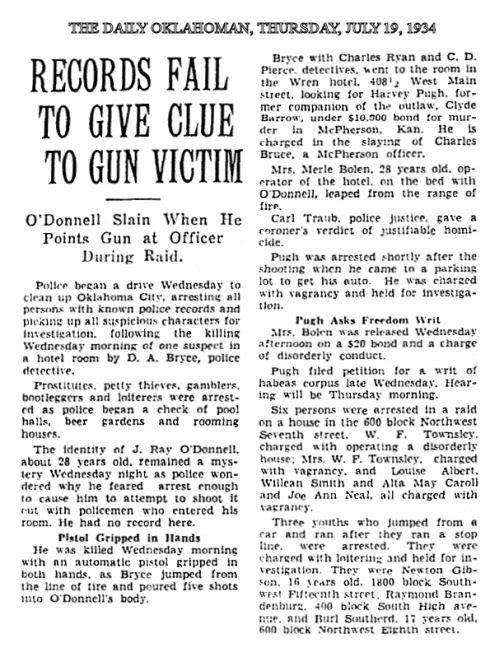
Want more? See the book at Amazon:
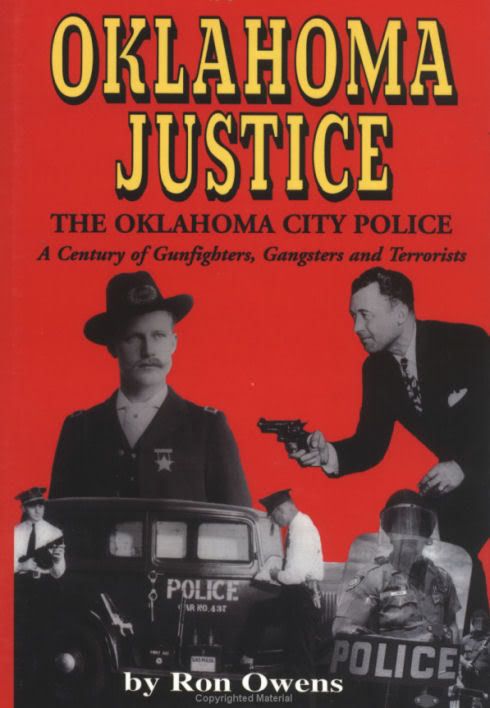
Egbert Hotel. Originally built by 1905 in the 100 block on North Broadway as the "Bassett Building", the Oklahoman's archives show that it became the Egbert Hotel in July 1915 and was owned by J.J. and Charles Egbert.
Edwards, Oliphant & Ottaways' Vanished Splendor, Vol.III (Abalache Book Shop Publishing Co. 1985) gives a little description of the 1905 postcard shown below: "The Basset[t] building is the five-story red-brick structure. In later years it was known as the Egbert Hotel. Bishop's Restaurant occupied the ground floor." Today, the space is occupied by the east end of the 1st National Center.
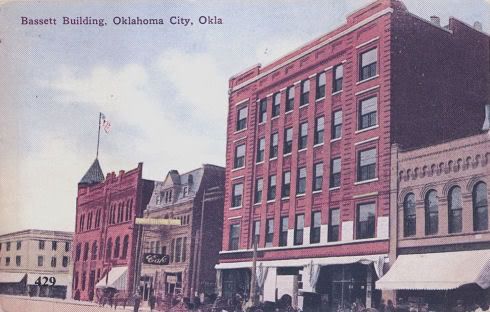
1925 Photo by McArthur
Credit: Terry L. Griffith, Oklahoma City – Statehood To 1930 (Arcadia Publishing 2000)
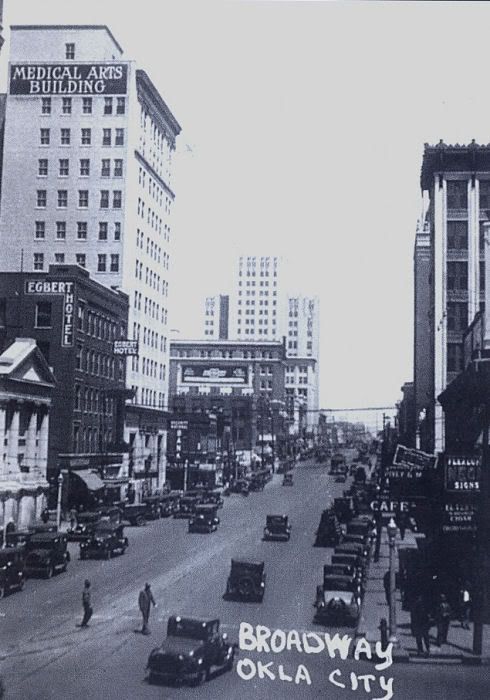
1918 YMCA. The "Y" shown below was at 125 Northwest Second, and was built in 1918. Edwards & Ottaways' Vanished Splendor, Vol. I (Abalache Book Shop Publishing Co. 1982) states, "The old building, remodeled, still stands as part of the Kerr-McGee office complex." However, if it did, it seems to be gone today. I'm checking on that. Also, see the 1952 YMCA, below.
Credit: Bob L. Blackburn, Oklahoma County – An Illustrated History (Windsor Publications 1982)
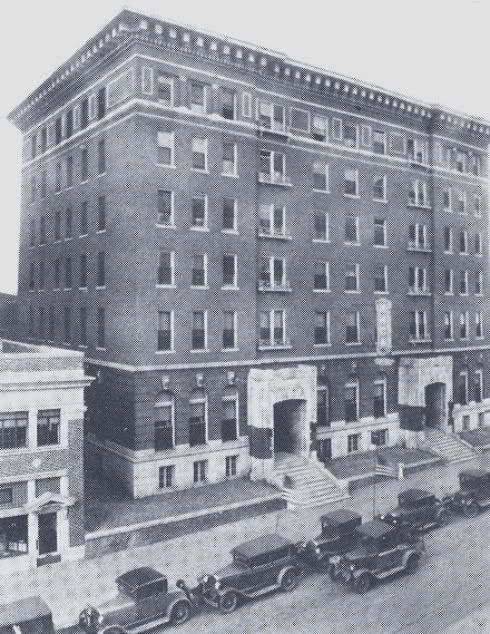
Oklahoma Club/Tivoli Inn. The Oklahoma Club Building (also called the Oklahoma City Club Building) was constructed in 1922 as a private club at 202-208 W. Grand (Sheridan) under the direction of John Shartel, then president of the club. During its prosperity, it was apparently a swank place, partly including apartments for its members and their out of town guests. A large ballroom was available on the 7th floor for members and outside organizations.
However, the prosperity didn't last and, according to an October 18, 1959, Oklahoman article, when a sale occurred to a former Oklahoman but then a New York resident, the 1959 sale was then thought to "end a 5-year period of financial difficulties for the Oklahoma Club." But, that was not to be the case. A mortgage foreclosure occurred in 1960, and in 1961, the property was purchased by George Phelps who planned to turn the property into a luxury apartment building. That apparently didn't happen since the property was advertised for sale in 1961 (see the ad below).
In 1964, the property was acquired by Leonard M. Hanson who reconditioned the property, including the adding of a facade, and it became the Tivoli Inn, shown below (the name being taken for what was then proposed by the city to be the "Tivoli Gardens." As it developed, the city included the property in its Urban Renewal plans, it was demolished in 1979 and became a part of the "Myriad Gardens."
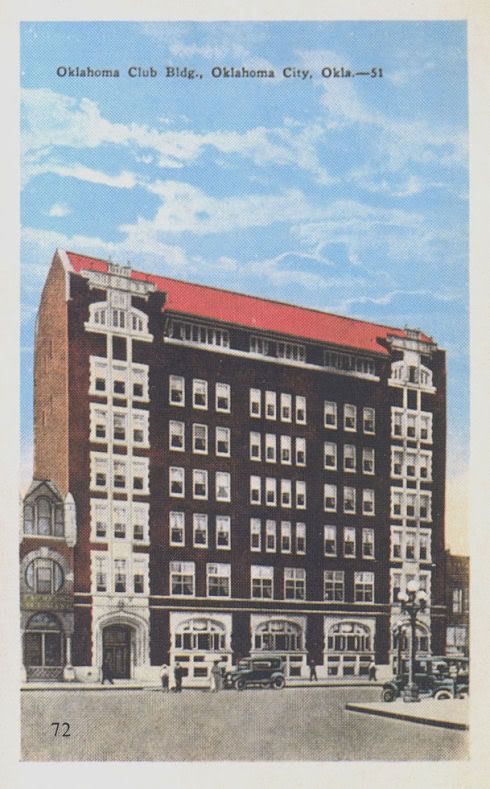
The Oklahoman 1961 Ad (larger image not available)
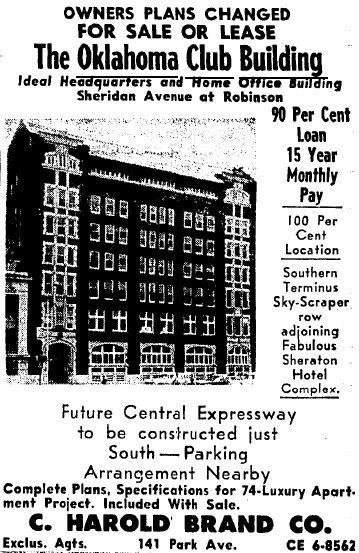
Credit: Oklahoma County Assessor's Photo Album (larger image not available)
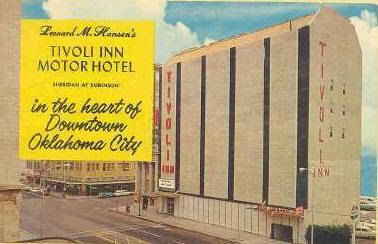
Wells-Roberts Hotel. Built in 1927 at 15 N. Broadway as the Wells-Roberts Hotel, it eventually became simply the "Roberts Hotel." It was destroyed in 1973 and the space is now occupied by the City Center Building's expansion.
Credit: Oklahoma County Assessor's Photo Album"
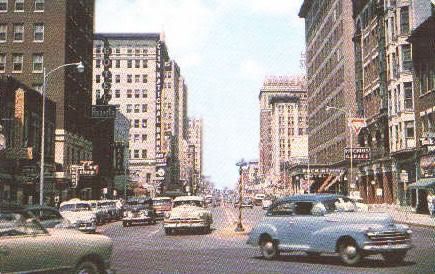
The Lobby
Credit: Edwards & Ottaways' Vanished Splendor, Vol. II (Abalache Book Shop Publishing Co. 1983)
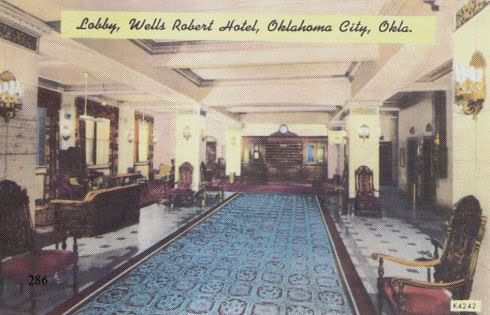
A 1955 Postcard From Doug Dawgz Collection
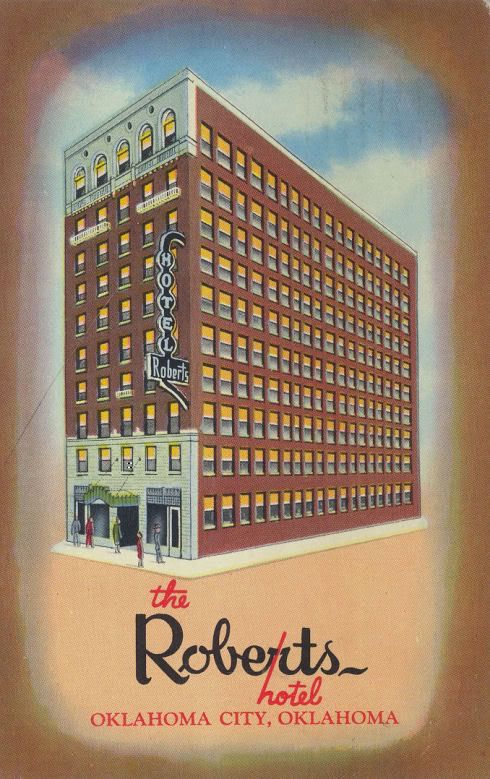
The Sieber. Built in 1928 at 12th and Hudson by Swiss immigrant Robert G. Sieber, the Sieber was said by Edwards & Ottaways' Vanished Splendor, Vol. II (Abalache Book Shop Publishing Co. 1983), source of the image below, to be one of Oklahoma City's "first apartment hotels." Even though the property has been vacant for many years, as this is written it is at long last under reconstruction to become a condominium and/or apartment facility, as shown in the 4/1/2007 pic below.

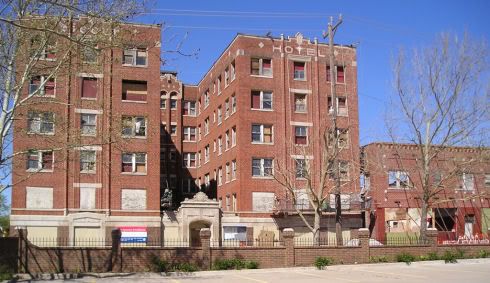
Hotel Black. Built by Lucian Black in 1930 at the northwest corner of Grand (Sheridan) and Hudson, the 11 story hotel contained 200 rooms. Its style is referred to as "Native American Art Deco." Originally, it included the parking garage to its north on Hudson. Today, the "hotel" part is an office building known as "One North Hudson." The parking garage survives as such to this day but is not part of the main building.
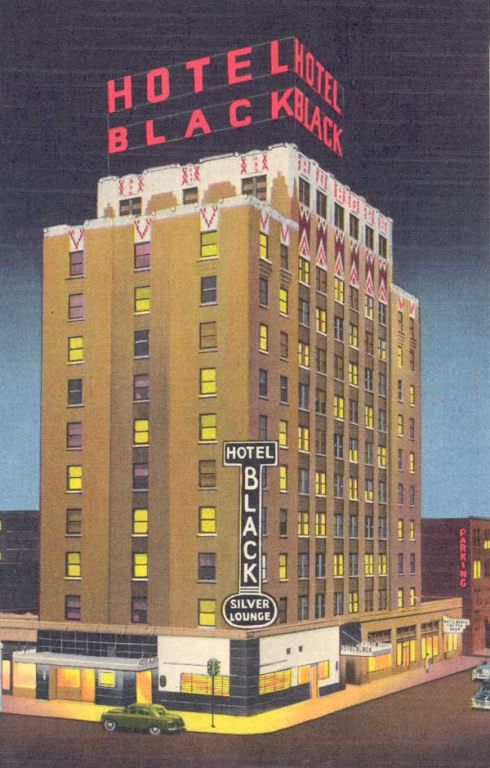
The Building Today, From Doug Dawgz Collection

Hudson Hotel. It opened in 1930 at 331 W. Grand (Sheridan) at the northeast corner of Grand and Hudson (across the street, east, of the Black Hotel) and is said to have catered to traveling salesmen. The building was destroyed during Urban Renewal days and, today, its space is occupied by the Center City Parking area.
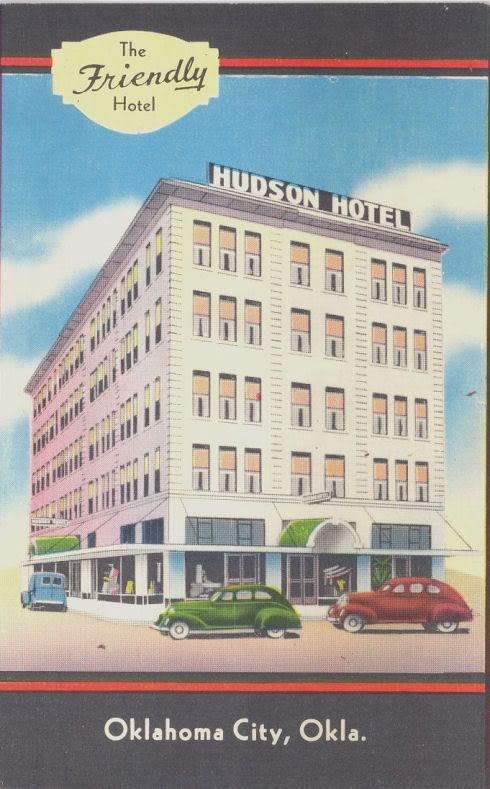
YWCA. Built in 1931-32 near the southeast corner of 1st Street (Park Avenue), it provided living quarters for young women. The dining area shown below was open to the public. It was immediately south of the current Oklahoma County Courthouse. It was demolished in 1979.
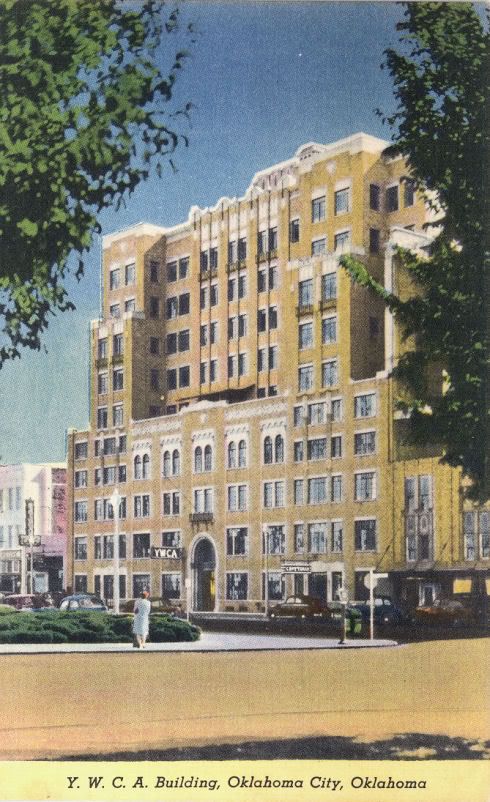
Credit: Edwards & Ottaways' Vanished Splendor, Vol. I (Abalache Book Shop Publishing Co. 1982)

The Biltmore. Construction of this lost treasure was done in 1932 and, at 26 stories (not including basement and sub-basements), it boasted that it had become the tallest building not only in Oklahoma City but in Oklahoma – whether true or not (both the 1931 1st National Center and 1931 the Ramsey Tower were 33 stories. A March 8, 1932, Oklahoman article says that it had 619 rooms. Built at the southeast corner of Grand (Sheridan) and Harvey, it eventually fell prey to Urban Renewal (though in the Pei Plan that was not planned) and was destroyed on October 16, 1977, as thousands of onlookers watched. In its latter days, it became the Sheraton Oklahoma before its doors closed for good in 1973.
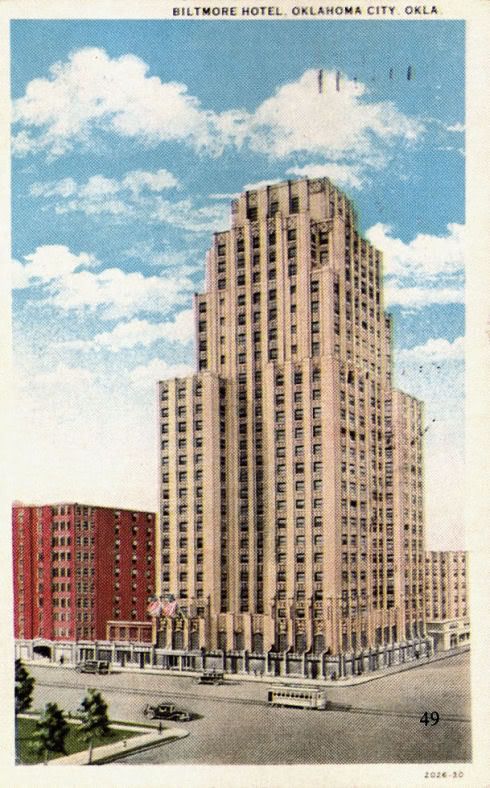
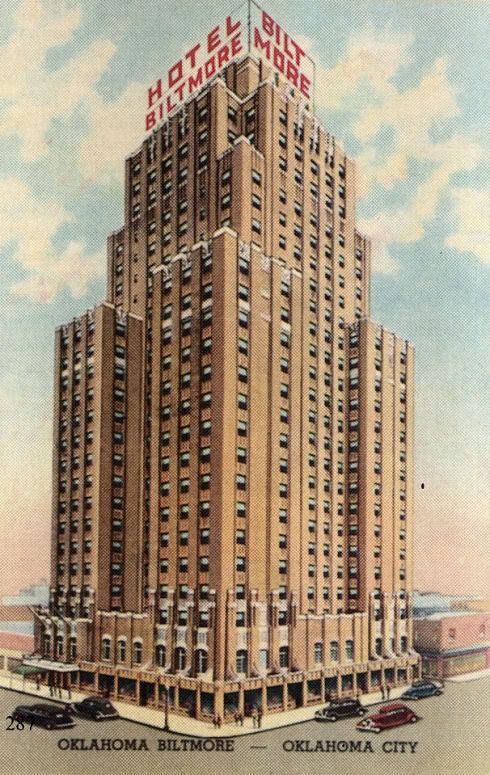
In The 1960s (larger image not available)

Big Time Thanks To Norman Thompson For The Following Brochure Scans Circa 1950s


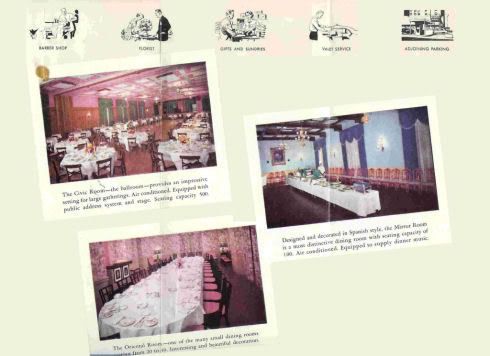
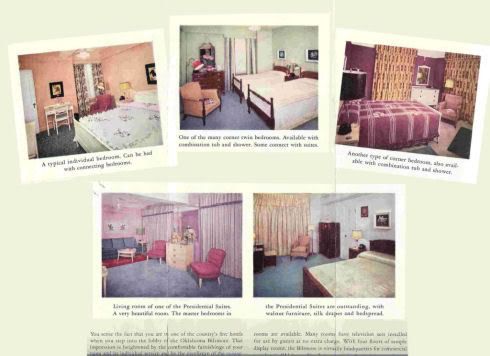
Daily Oklahoman Front Page, October 16, 1977
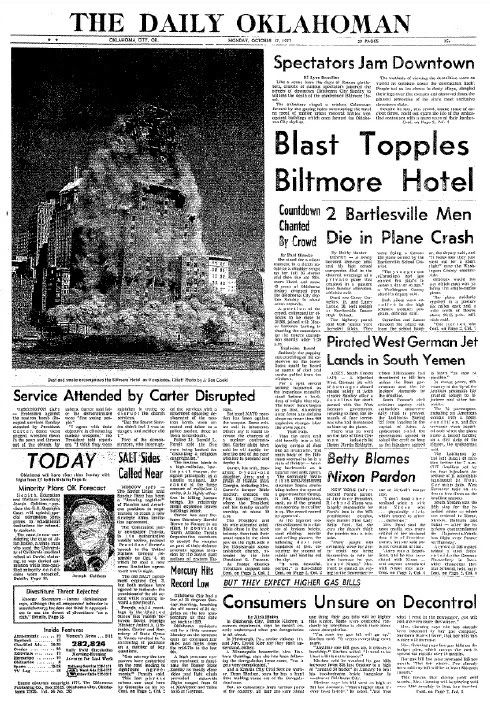
And Down She Came (larger images not available)
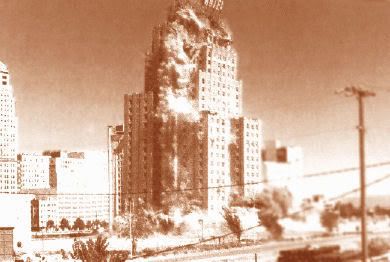

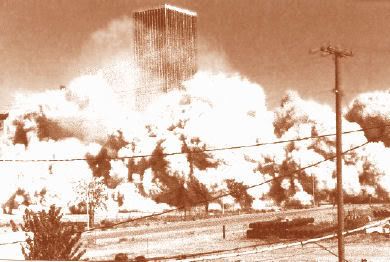
Skirvin Tower. When construction started on the Skirvin Tower in 1931 at the Northwest corner of Park Avenue & Broadway, it was intended to be 26 stories as shown in the postcard rendering below. Resources dwindled, construction was delayed, and plans were scaled back. It was done in 1936 at 14 stories. Balliets was a tenant from 1936-1972. WKY Radio operated here from 1936-1951 (TV from 1949-1951), occupying 2 floors. An underground tunnel, the first in the city (I think) connected the Skirvin and Skirvin Tower, as shown below. The building was gutted and completely rebuilt in 1971-73 and renamed as the 101 Park Avenue Building. During the Urban Renewal Period and before the Oil Bust and Penn Square Bank collapse, plans were in place to add 14 stories, but that didn't happen.
As Originally Contemplated and As It Turned Out
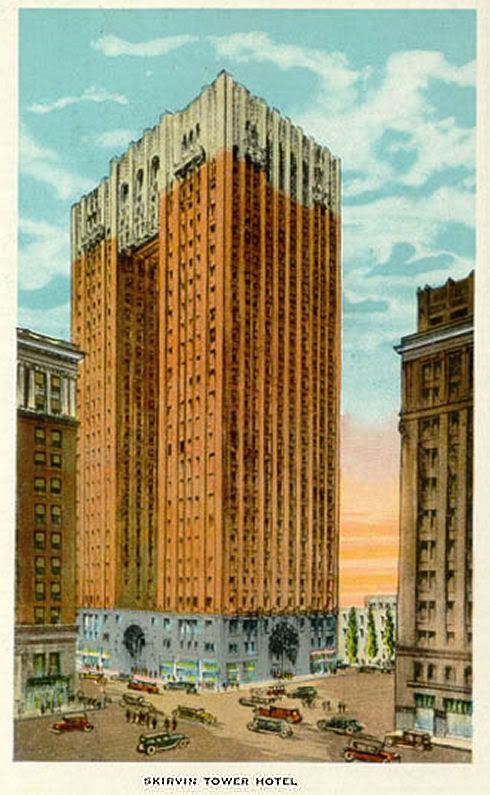
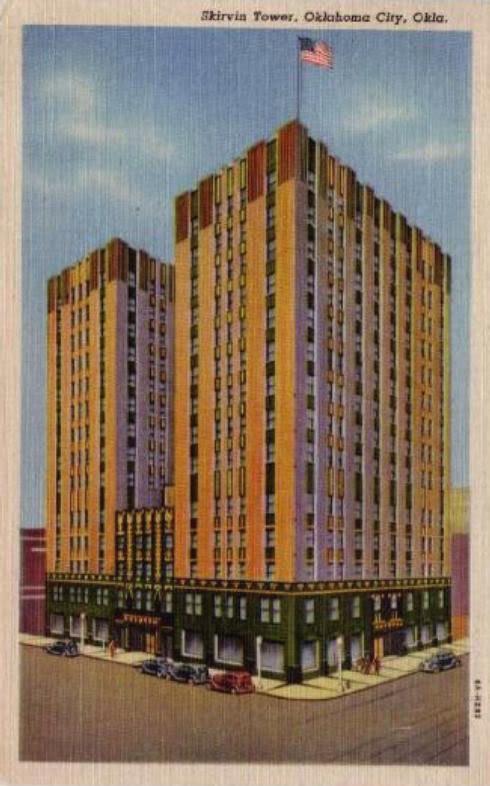
The Connecting Tunnel With Nice Murals
From Dan Mahoney's Press Kit

When WKY Was A Tenant (larger pic not available)
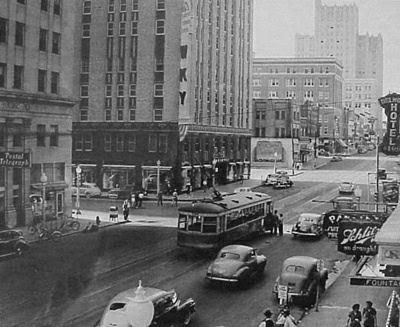
From OKC: 2nd Time Around (next 2 pics – larger images not available)
Conversion to Offices As The 101 Park Avenue Building
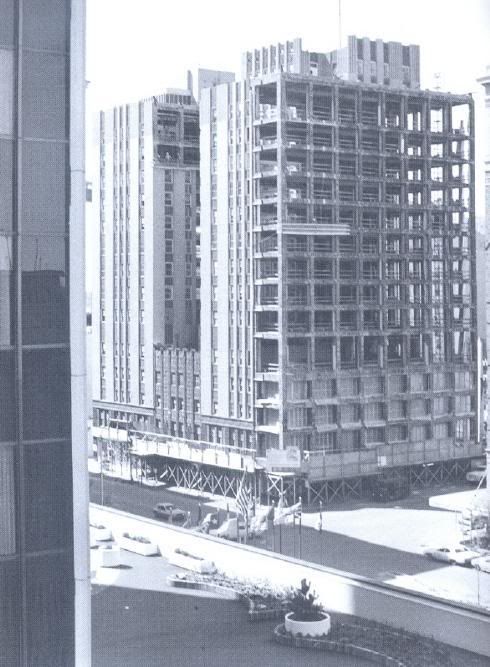
The Planned Expansion
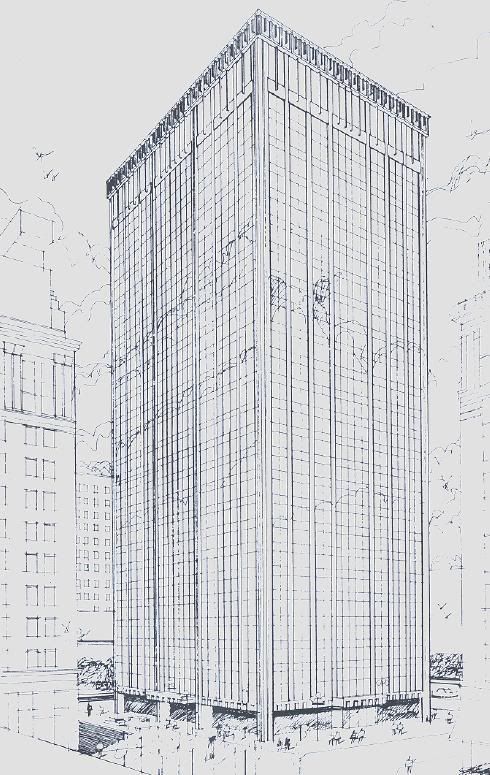
USO Club. I'm not able to date this building's original construction, but, by World War II days it was the USO Club at 431 W. Main – generally south and slightly east of City Hall on the north side of Main, between the Hightower Building on the east and the city-owned building on Walker on the west (now a parking lot) – hence I'm sticking it in the early 1940s time period since I have no better information. The image below is from Edwards & Ottaways' Vanished Splendor, Vol. II (Abalache Book Shop Publishing Co. 1983) and this description is given:
The U.S.O. Club was a serviceman's headquarters, offering conveniences and diversions such as correspondence desks, laundry facilities, big comfortable divans, overnight bunks, a library, check and checkers, ping-pong, archery, and a cookie jar ... a real home away from home.
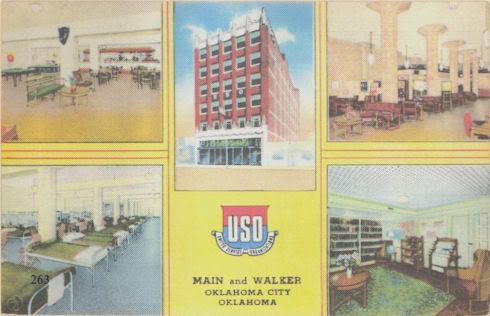
1952 YMCA. According to an April 9, 1952,Oklahoman article, an estimated 10,000 people attended the open house preview of the new YMCA on April 8, complete with inside and outside activities and music. Built at the northeast corner of 5th and Robinson, an April 6 Oklahoman article said that the facility was "considered to be the most modern in the nation."

Following the 1995 Murrah Bombing, the building was razed. The building had not been rendered structurally unsound by the bombing, but it did suffer substantial superficial damage. I am advised that the building was one of a handful of International Style buildings remaining in the United States, and, even though civic efforts were made to preserve it, the building's owner apparently considered that a street-level parking lot was a more appropriate use for the property, and the building was unnecessarily destroyed. From a generous anonymous source comes this greater detail:
It would be historically accurate to state that The City of Oklahoma City was offered the building free of charge by the YMCA, but The City declined because of fear of the cost to abate the asbestos in the building.Following meetings with the YMCA supporters, a legal defense fund was organized and an appeal was filed in District Court. See the case docket sheet here. But, after spending about $25,000 on legal fees and with litigation costs having no end in sight, the case was voluntarily dismissed, and demolition of the building began in June of 2001.
After The City declined to accept the building from the YMCA, it was purchased for about thirty thousand dollars. After a year or so of inactivity, the City began putting pressure on the building’s owner him to do something with the property. OKC had spent about $60K to have the building boarded and cleaned up and also was also concerned because of the negative visual impact due to the buildings proximity to the Murrah Memorial.
An investor entered the picture and decided that demolition of the building and construction of a surface parking lot would be a profitable investment. As it turned out, perhaps that was the case. The City recently purchased the parking lot from him at a price that I believe was a profit.
But, earlier, there was quite a bit of media coverage and public controversy surrounding the effort to save the YMCA building. Several members of the architectural and engineering community and others joined in this effort. A redevelopment plan and proforma was developed that demonstrated the economic viability of the building. Three hearings in front of the Urban Design Commission resulted in a denial of the demolition permit based on the same language in the Urban Design Ordinance that kept Bank One from arbitrarily leveling the Gold Dome Bank Building. However, after two hearings before the Board of Adjustment, the UDC decision was reversed and the demolition permit was approved.
Holiday Inn. The downtown Holiday Inn was built in 1964 at 520 W. Main, has had a checkered hotel history, finally closed as a hotel at about the same time that MAPS was announced, and has an intriguing present use history.

It would take too much space to closely track the change of ownership and names of this 10 story hotel while it was a hotel than relevance would warrant (even though I've done that) ... suffice it to say that various Oklahoman articles trace this lineage: the Downtown Holiday Inn was announced in 1962; it opened and operated as a Holiday Inn from 1964 until 1978 when it was sold to a Vancouver group of Canadian émigré investors originally from Tanzania in 1978 when it became a Quality Inn; in a series of transactions in 1981, it wound up being owned by the same group that then owned the Skirvin Plaza – they closed the hotel in April 1981 until it reopened in 1982 as the Holiday Inn Centre, which closed, "indefinitely", in March 1986; after various transactions, the property became owned by a Washington D.C. group in October 1990 which planned to reopen the hotel; in May 1991, the owners announced that the hotel would reopen "in 60 days" – which kinda-sorta happened – it became the "Commonwealth Park" with some of the rooms available within that time frame, even though during this ownership not all floors of the hotel were open – by the time "eviction" litigation began in January 1993, only 125 of the 200 rooms were available for occupancy; it continued after that, but as "The Commonwealth Elite," but that closed in September 1993.
That event brings us to the M.A.P.S. period in time. A September 19,1993, Oklahoman article reflects the state of downtown hotels only 13 to 14 years ago: The headline read, "Lack of Hotels Clouds Plans For Downtown," and an excerpt from the article said:
Oklahoma City's ambitious $254 million downtown redevelopment plan unveiled Wednesday begs the question: If we build it, and they come, where will they stay? * * *Since then, the property never reopened as a hotel.
Downtown's sole operational hotel is the Century Center, and it owes $167,000 in back property taxes for 1990, 1991 and 1992. It will sold to satisfy those tax liens in June 1994 if they remain unpaid, officials in the Oklahoma County assessor's office said last week.
Last Wednesday's announcement of the far-reaching Metropolitan Area Projects Master Plan ironically came just days after the Commonwealth Park Hotel, 520 W Main, called it quits. A spate of liens has been filed against the property.
The historic Skirvin Plaza Hotel was closed in 1988 and has not reopened.
On a cold day, January 1 or 2, 2006, with downtown pretty much deserted, I was driving around taking some pics for my as yet undone new "clickable" downtown map and I drove by the site. A couple of pics below show what I saw.
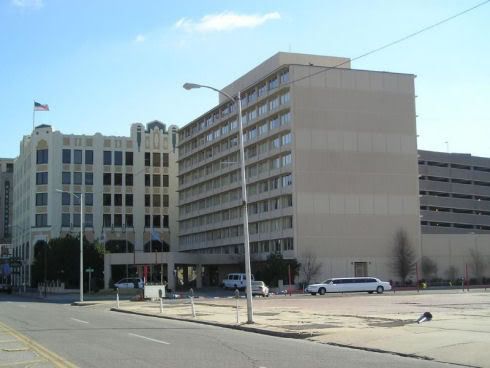
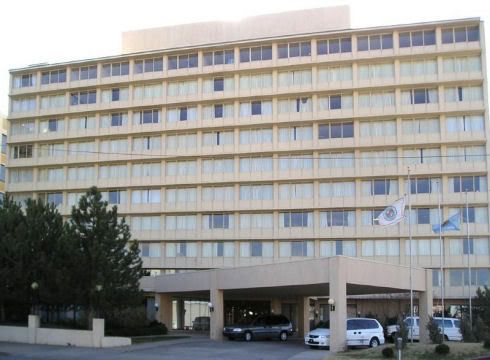
"Hmmm," I wondered, what's the deal with that limo?", and, "Why is the City of Oklahoma City flag in front of the building?" I got out of my car and went to the front door ... no signs indicated what the building was or was used for, and the doors were locked. Since the day was a holiday, that made sense. I thought maybe it was a building used by the city these days, given the city flag out front.
I came back a few days later that was still biting cold outside and rang the bell (since the front doors were locked). A pleasant young lady came to the door, spoke with me, did not invite me in, but, after a time, she allowed (at my request) that I enter the lobby since it was so damn cold outside! The lobby area was beautifully appointed just like a fine hotel would be. At the lobby desk, we were joined by another pleasant young lady. There, I asked a few but not many questions (understanding that I was an uninvited guest and not wanting to be too pushy) and not necessarily in this order:
(1) Was the building owned/used by the City of Oklahoma City (given the OKC flag flying in the frontage)? Answer: No.
(2) What is the building used for? The young woman who allowed me in said something like it was a character development center. I said, "You mean, like a rehabilitation center?" She said, no, it had nothing to do with rehabilitation. I asked her to explain a little. I don’t recall her exact answer, but it had to do with training programs to build character. Not really understanding and not wanting to be too nosey, I asked if I could have a brochure or something simple, and she gave me a single sheet "flyer" type of paper with the name "Character Council of Oklahoma City" at the top and which contained a picture of Mayor Cornett at the bottom. I asked if there was a website where I could read more, and the young lady gave me this address: http://www.characterfirst.com and, later, I noticed another name on the "flyer", http://www.characterok.org. She also said that a monthly breakfast and lunch was available, the next being 1/24 at 7:00 a.m. and 1/26 at 11:45 a.m., and that I would be welcome to attend (after telephone a fellow to let him know for planning purposes). I asked about the condition of the building above the lobby level and I was told that most of them had been reconditioned, all but 2 or 3. I did not ask what they were used for but didn't get a clear answer about that. That was pretty much the extent of my visit and I left with good feelings generated from the pleasant ladies but still not knowing a lot more than I did in the first place.
To cut to the quick, my subsequent internet research revealed that, in December 1993, the property was purchased by Kimray, Inc., for the stated purpose (according to a December 22, 1993 Oklahoman article) of being used as "a Christian-run rehabilitative facility for troubled youth." The article stated the new owner's intention to transfer the property to the Institute in Basic Life Principles, "led by Chicago evangelist Bill Gothard." The article also said that, "Mayor Ron Norick said he supports the project because he has received correspondence from other cities' leaders endorsing Gothard's group."
The former Holiday Inn is now part of Bill Gothard’s Institute in Basic Life Principles which I learned from my research to be a very conservative and somewhat controversial organization led by the Hinsdale, Illinois, person, Bill Gothard. Since December 28, 2000, that organization has owned the building. Since this post is about hotels and not under-my-radar religious and/or character training stuff, I'll leave this discussion with a couple of web links for the curious: http://www.iblp.org/iblp/about/, http://www.midwestoutreach.org/02-In.../Gothard-IBLP/ and http://www.apologeticsindex.org/i13.html for example. A Wikipedia description is here. This bit of research was simply born out of curiosity of what the former Holiday Inn was being used for in my expanded downtown Oklahoma City map! Actually, the "find" was pretty cool even if perhaps a bit on the "dark side."
THE PRESENT. In addition to the Skirvin Hilton and the Colcord Hotel, each having their own posts here, the following are the operational hotels in downtown as this is written, six altogether (in this chornological order): Sheraton Century Center, Marriott Renaissance, Courtyard Marriott, Colcord Hotel, Marriott Residence Inn, and Skivin Hilton. As said before, the Skirvin Hilton and Colcord Hotel are covered in separate posts here. The other 4 are described below.
Sheraton Century Center. Announced in May 1973, the Sheraton Century Center was originally proposed to open in 1975, but delays occurred and, finally, on January 2, 1977, the $18 million 395-410 room (reports vary) hotel was open for business (the commercial part west of the hotel did not open until several months later). Connected to the underground tunnel system including the Cox Convention Center, it was the first new hotel downtown since the Holiday Inn was constructed in 1964. It has had some ups and downs but seems to be doing well lately with some needed improvements. The Center occupies the block bounded by Robinson and Broadway on the west and east and Main and Sheridan on the north and south, entering the hotel on Broadway. Parking is available underground.
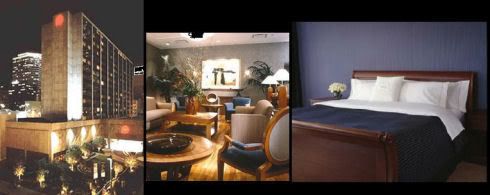
Marriott Renaissance. Announced in October 1995 with a planned opening for fall 1997, Springfield, Missourian John Q. Hammons' initial downtown hotel venture opened on January 29, 2000. The $38 million (or so), 311 room 15 story hotel gave downtown its second operating hotel (the Skirvin was closed in 1989 as did the Holiday Inn in 1964). It's an elegant piece of work!
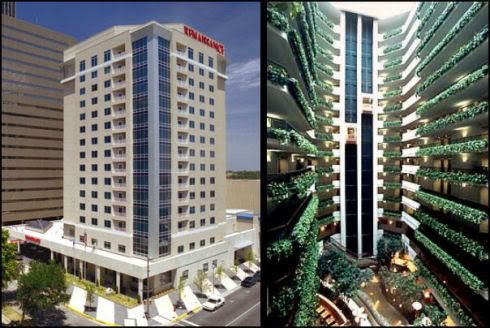
As Viewed From The Harkins Cinema Area
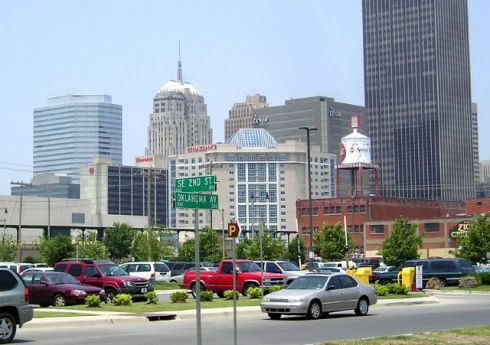
Same View But From Gaylord
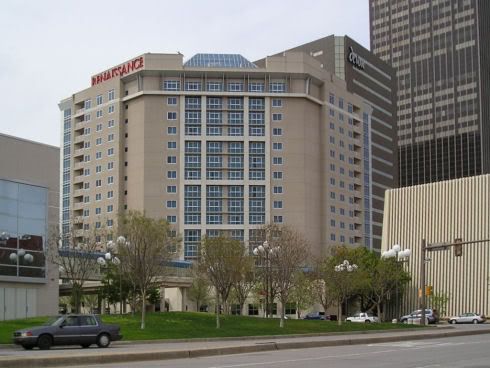
Courtyard Marriott. Hotelier Hammons' 2nd venture into downtown was the Courtyard Marriott immediately east of the Ford Center. It, and its associated public parking garage to its south, were completed in January 2004. At a cost of $18 million and at 225 rooms, this better-than-usual (for a Courtyard) project gave downtown three operating hotels. The 2nd pic below was taken on March 28, 2007.
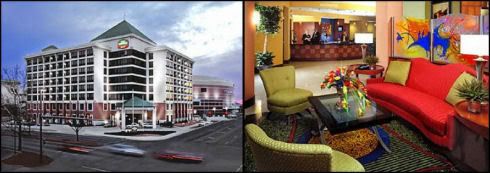
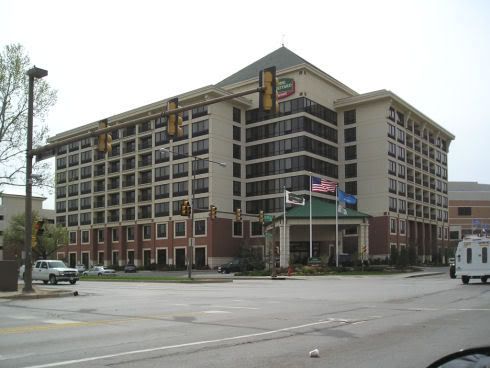
Marriott Residence Inn. Mr. Hammons' 3rd venture downtown is the Marriott Residence Inn which opened in December 2006. A June 6, 2002, Oklahoman article quotes Hammons as saying, "Boy, Oklahoma City is really coming out of it, isn’t it?" said Hammons, whose companies own more than 80 hotels. "Oklahoma City's downtown is going to reestablish itself in a very dominant position – it's a new world that's going to develop down there." And, indeed, it is! Excerpts from Steve Lackmeyer's March 7, 2006, Oklahoman article describes Hammons' attitude and activity:
Hotel developer stays true to his wordThe 150 room Bricktown hotel is located at Reno and Joe Carter, just west of the Outdoor World. the pics below were taken on March 28, 2007.
* * *
Hammons arrived in downtown Oklahoma City at a time when we weren’t quite sure about our future. Residents had voted for a penny sales tax to make over the city. Hammons came and promised to build not just one but two new downtown hotels.
But after the initial post election euphoria following the 1993 passage of Metropolitan Area Projects, the projects became a public relations nightmare for city leaders. Almost every story seemed to include the phrases "over budget" and "behind schedule." And as the projects seemed to stall, so did plans for Hammons' promised hotels.
A couple of years later, I tested Hammons' resolve by reporting the Missouri developer was about to violate a development contract deadline with the city to build the first of the two hotels across from the convention center. I couldn't reach Hammons for comment before the story appeared.
But he called me when the story hit the paper.
"I'm not upset with you," he said. "You called a spade a spade. But I'm going to build this hotel. And when that's done, I'll build a second hotel when the city builds the arena."
Hammons kept both promises. And he has proceeded with plans to build a third hotel – a Marriott Residence Inn – along the Bricktown Canal.
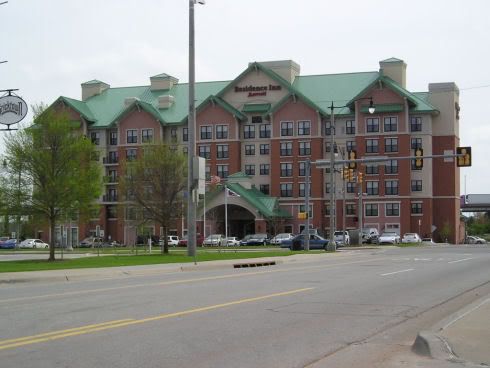
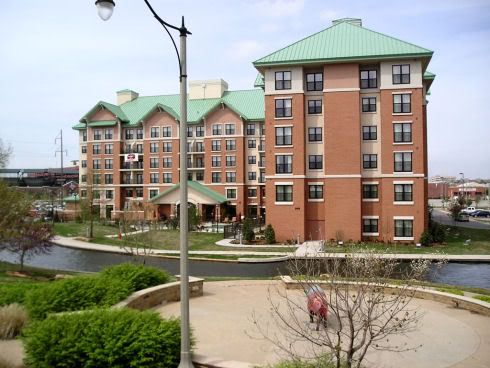
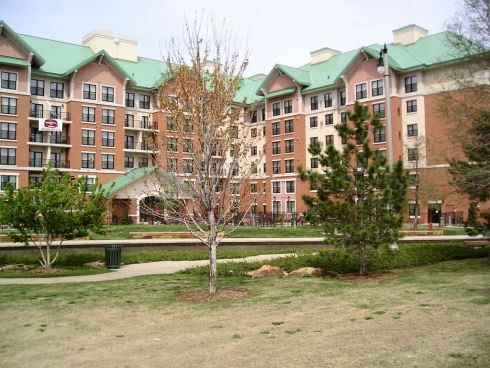
The Lobby and Adjoining Room
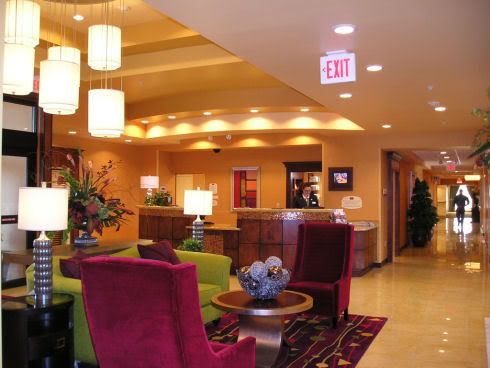

THE FUTURE. In just a few years, downtown has gone from 1 (Sheraton Century Center) to 6 (Sheraton Century Center, Marriott Renaissance, Courtyard Marriott, Colcord Hotel, Skirvin Hilton, and Marriott Residence Inn). Doug Dawg is well known not to win wagers, hence he doesn't make them any more. Maybe I am a Missouri, "Show me!", kind of guy. Without wagering, I'll just ask the question, "Is Mr. Hammons going to build yet another downtown hotel?"
A part of Steve Lackmeyer's March 7, 2006, Oklahoman article reads,
Hammons' news releases typically come weeks after his projects make the news. He owns a company that operates hotels across the country, yet he still personally handles most interviews concerning his developments.We shall see. The "this year" about the announcement comment has come and gone.
The big mystery in town now is his insistence that he plans to build a fourth hotel –an Embassy Suites – somewhere downtown, likely in Bricktown. Officials at the Oklahoma City Urban Renewal Authority say they have no active discussions with the developer. Major land developers also claim to know nothing of any pending deal.
Hammons won't say much more about the Embassy Suites, other than an announcement will be made sometime this year. When pressed, he slyly responds, "I know where I’m going to build it, and I'm going to build it." He knows we want to know more. But it looks like he’ll keep us guessing for a while. * * *
* * * when Hammons says he's going to build a hotel, even if the details remain sketchy, experience says we can expect something will happen.
Hampton Inn. In the meantime, one project is on the books and is apparently underway, the $27 million 9 story 200 room Hampton Inn to be built immediately north of the Bricktown Ballpark and east of Pittman's parking garage on Sheridan. Originally announced by Marsh Pittman as a 10 story hotel in October 2005, the final project at 9 stories appears to have cleared legal hurdles even though a ceremonial ground breaking scheduled for December 2006 was delayed – it may have since occurred, but as of a February 15, 2007, Oklahoman article, that apparently did not occur since approval of adjustments were needed by city authorities which were granted on that date. Construction is projected to be completed in 2008. Ground has been broken, and the architect's rendering of the original proposal appears below.
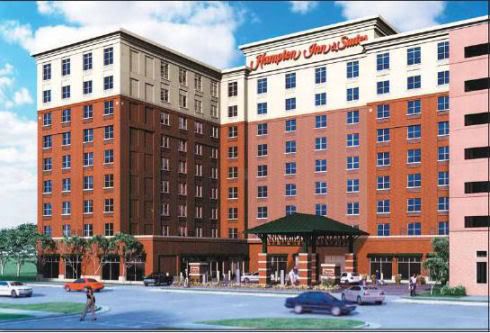
Top














25 comments:
So many beautiful buildings.
Shane
It was fun to see all those hotels. I remember when the Biltmore came down--wasn't there, but saw it over and over on TV.
On the Lee-Huckins: don't forget its role as temporary state capitol in 1910, after Oklahoma City won an election to be the new capital.
Doug, you are something else. I need to leave more comments at your blog. I read it and don't tell you enough what a great job you do. This post on the hotels took an amazing amount of research and time -- and the result is masterful. truly. I said this in a post over at OKCTalk, but I really think you missed your calling as a historian. But then again, you're proving one can make up for lost time. This is marvelous work, Doug.
-writerranger-
Thanks, writerranger, very much apprciated!
It's good to be appreciated even though, to be candid, I just do this stuff for my own pleasure ... I DO love this town of my birth! Your town and mine, we are the same!
I know what you mean. It's obviously a labor of love and the passion comes through.
I have a postcard of the Biltmore in its last days when it was a Sheraton and had the Sheraton sign atop the building. I'll see if I can find it and I'll get it to you.
I don't understand why you would term the Holiday Inn's current function as being on the "dark side." Helping at risk teens seems like a very responsible thing to do. I'm sure the reason that the ladies were being coy with you is due to privacy issues. I've given talks at places such as this and they are very guarded about the privacy of the residents for a reason.
Otherwise, it was a very interesting article.
Thanks, anon.
"Dark side?" Yes, I do have an inherent suspicion if not distrust about things that are just "there" but are under the radar of most in the community, so to speak. I like the "light of day" approach, where everything is "out front," to anything, public or private, no "quiet speech" library-motif necessary. I think that it's safe to say that the resident organization is not even known of by 99% of Oklahoma City residents. If the organization has a "public" profile, I've surely missed it. Why is there no "press" coverage or other public release news items when conferences, etc., from this organization are held? But, perhaps such things have occurred and I've missed those notices, as well.
I've no particular interest in debating or discussing the merits, origins, or whatever, of the Character First organization here, perhaps nowhere at all, but from what I've read I do have VERY serious issues with Bill Gothard’s Institute in Basic Life Principles, upon which the local organization seems to be based, unless I'm misinformed about that.
As for the young ladies that I spoke with when doing my walk-about-tour, they were most polite and congenial (even if I was reluctantly granted access to the warm interior from the ice-cold exterior for what my bones were telling me was a more than sufficient amount of bone-chilling time), and even if they seemed to me to be overly cautious about what they said, but that's how they were probably instructed to be. They were ladies through and through, and represented your organization well. No complaints here, aside from being colder on the outside than I'd like to have been!
Did you and I sit next to each other at the Chamber's luncheon regarding the March 4 vote, and discuss some of this stuff? Just wondering if you are the same person from Character First that I spoke with then.
Love to see the old neighborhood. Born in 1946 I lived at the Albany Hotel, 121 S. Harvey. I now know that is was of question able repute. I was sheltered from all of that and attended Villa Theresa until we move the suburbs. My Grandmother was the propriator from 1944 to 1954 approx. If you have any information regarding this "unworth" hotel. Please post it or otherwise let me know. Thanks. Jay
Dee Young.
Thanks, Jay. I'll see what I can find and will post again in a comment here.
I was there (as a 4 or 5 year old) the day the biltmore came down. My parents took my brother and I to see it from the side of one of the highways. It is one of my earliest memories. Thank you for posting the pictures here. Brings back all kinds of memories. Regarding the Ren. Hotel, my husband and I stayed there for our first night after being married outside at the myriad gardens on the water stage and what a great place! We didn't spring for a fancy room or anything but we didn't need to. It's very well done, beautiful on the inside and the staff does a tremendous job.
Thanks Doug for a great site!
You're welcome, Stormy. Come back often!
I was one of the thousands there when the Biltmore came down. I was a HS Junior and several of us went down to see it. I filmed it on Super 8 film and it was the last movie shot on dads color film movie camera before we all started converting to video tape.
My father, now 83, asked me if the Black is still standing. From your blog it appears to be but my sister and I thought we remembered it being demolished. We'll drive by the next time we are back home to OKC.
Hi, John,
Yes, the Black is still standing and doing fine. A contemporary picture of it is immediately below its postcard, above. Today, it isn't a hotel but is an office building and it is called One North Hudson. The new 50 story Devon Tower is being built on the opposite (east) side of Hudson. But, if you want to see for yourself, use the on-line bing/ms maps ... click here ... and then turn on bird's eye view.
Thank you for this excellent website.
An article that I found might interest you and your readers.
"Oklahoma City Ablaze.
The Milwaukee Journal - Nov 1, 1898
Fire Breaks Out In Hotel And An Entire Block Burns
Guthrie, O.T. Nov. 1- This morning fire broke out in the Commercial Hotel and within half an hour almost the whole block was in flames. The wind is blowing a gale and the prospects are that the town will suffer to a great extent. The fire department of this city is sending assistance. Oklahoma City is thirty miles away."
Additional information about this hotel has not been forthcoming. Please post if you find anything.
Keep up the great and important work!
I stayed in the Hotel Black in 1973 while waiting to enter the army. It was pretty ran down by then but you could tell that it had once been a very nice establishment.
in the images of the Skirvin Tower there is a B&W photo from Dan Mahoney's Press Kit: on the east (right) side of Broadway is a sign for a hotel. it is cut off on the right but it looks like it says "Del Mo" (Del Mont?) Hotel.
I cannot find on single photo of this southeast corner of Park and Main.
Does anyone have any info on or photos this hotel? My dad lived there for a year or so when he was little. I would love to get an image or information on it.
thanks guys
TeeRoonie,
I think you mean the southeast corner of Park & Broadway, which is the vantage point of the photo you mentioned. I've done some checking and this is what I've found:
1) Sanborn Maps: The 1929 Sanborn map of the area shows that a rooming house was located at that location, probably on the 2nd floor, and the address was probably 118 or 118 1/2 N. Broadway. The 1929-1949 updated Sanborn Map shows a hotel at the location, again, probably on the 2nd floor. Here's a link to the 1949 version. By the time that the Sanborn map for the area was updated in 1955, the area north of the Insurance Building (it had different names) had become a parking lot.
2) Oklahoman Archives: I searched the Oklahoman's archives between 1920 & 1959, looking for similar addresses (122, 120, 118 N. or 118 1/2 North Broadway) and also tried to locate a hotel by any name at the same locations, and also a hotel at any location which began "Del Mo" (including Del Mont). No hotels at all were found as a result of those searches, not even a want ad for a rooming house.
However, various Oklahoman items did indicate that people lived at 118 or 118 1/2 N. Broadway. Go back and look at that picture you mentioned earlier. Notice that behind the Schlitz sign a partially obscured sign appears beginning "PA" ... I found Pan-Tex Cleaners ads at 118 N. Broadway in 1933 and 1935 ... and the obscured parts of the sign seem to match that possibility ... so my guess is that the "Del Mo..." hotel was located above that cleaners at 118 1/2 N. Broadway at the time that the photo you mention was taken. In 1947-48 several ads appeared for 118 N. Broadway for an outfit named "Prescription House." The last instance of any "finds" for 118 or 118 1/2 N. Broadway occurred during 1948.
My best guess is that your dad lived at 118 1/2 N. Broadway. This possibility is strengthened by other items found in the Oklahoman: Articles concerning liquor arrests were found for a few individuals whose address was given as 118 1/2 N. Broadway (1938, 2 times in 1940, and in 1947 (although the address given for the 1947 item was 118 N. Broadway)). A man living at 118 1/2 N. Broadway got a marriage license in 1942 and someone who received US citizenship was stated to live at 118 N. Broadway in 1940. Although the sign in the photo you mention shows that a hotel was present, most probably it was a 2nd story rooming house which was not an uncommon coupling in those days and earlier.
3) Photographs: The 2-story building you're wanting to see was flanked by the Skirvin Hotel on the north side of Park Ave (1st Street) and the Insurance Building at 114 N. Broadway. While I could not find any photos which focused on the building you want to see, the building (actually, a pair of 2-story buildings but yours is probably the southernmost building) does show up even if not particularly well in a couple of photos of the Insurance Building. A 1911 photo is here -- the Insurance building was then used as OG&E headquarters. A photo taken around 1925 is here.
That's all that I could find and I hope this helps you a little in tracking down your dad's history.
I've been lodge in one of theses antique hotels when I was kid I have some interesting photos about their wonderful structures and the comfort that they offered to people.
Doug, Okay, I'm back again, this time on your hotel blog. Here is some interesting heresay about the above mentioning of a hotel by the name of DelMont (Delmont).
A grade school buddy, and the only one, says his father and grand father ran (owned) that hotel. Both were also bootleggers as a profitable side business. My old buddy says you could get a room, a bottle of bottled & bond, and a lady each for a $2 bill. Seems the Navy paid the sailors in $2 bills; God only knows why?
Some people or law types told them to get out of the bootlegging but they persisted because of the easy money. Both ended up doing 2 years in the pen for their troubles and one did an extra year for not keeping his mouth shut.
My old friend will be excited that I found some mention of that hotel that he remembers as a small boy in OKC.
I, myself, recall the sailors in downtown OKC, the arcades, Sweet Leona's among the beer joints, and everything else to pry those $2 bills out of the sailors' pockets. Think OKC was still a pretty wide open town and I think there was a book written called, "Sin City USA" about California Street and enviorns downtown some years ago.
FABULOUS RESEARCH! This kept me busy for hours! I am passing on the link!
Wonderful buildings. Very interesting.
Web Development Company| Web Designing|
Unthinkable pictures. Thanks for the share.
I've been lodge in one of theses antique hotels when I was kid I have some interesting photos about their wonderful structures and the comfort that they offered to people.
A late friend and work associate often talked about old downtown. I remember it as a kid because dad had a store down on Robinson. I was 5 years old when I started working there for nickels. My late friend said they brought down the Biltmore with its costly fixtures in place. It included pedestal sinks with real brass faucets. He offered to go in and salvage those items but the demo company would have nothing to do with it. It was not worth anything to them. The city didn't want anything getting in the way of bringing it down.
Quality articles or reviews is the main to invite the
people to go to see the web site, that's what this site is
providing.
Post a Comment